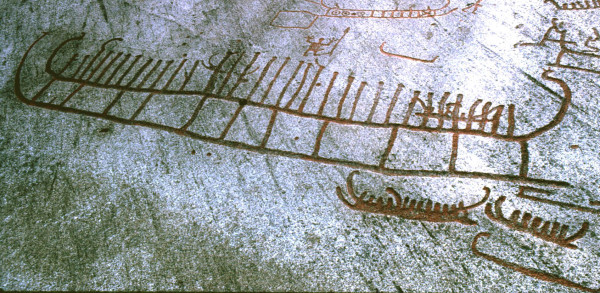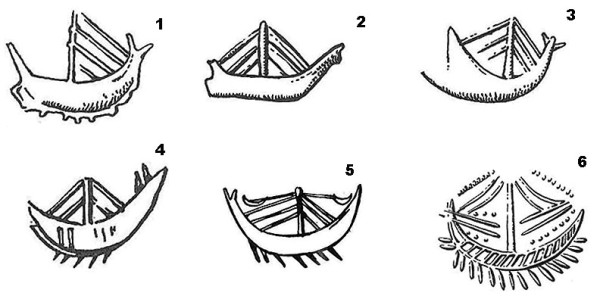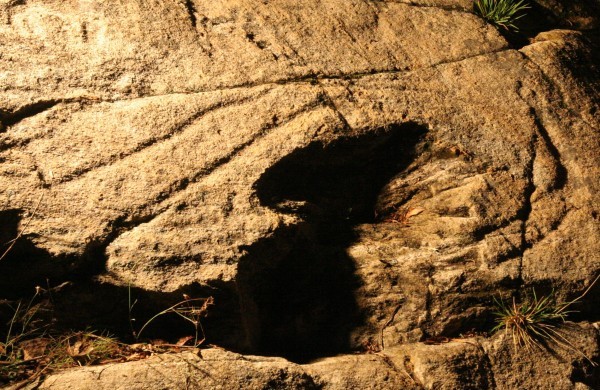It looks like you're using an Ad Blocker.
Please white-list or disable AboveTopSecret.com in your ad-blocking tool.
Thank you.
Some features of ATS will be disabled while you continue to use an ad-blocker.
17
share:
This Petroglyph Captures the Moment when Atlantic and Mediterranean Cultures Met

This is a very interesting read.
When and how the Mediterranean/Aegean trade and cultural package spread beyond the the straights of Gibraltar is a contentious subject.
Once this question is raised,it invariably morphs into an Atlantis this, Atlantis that conversation, but this particular set of evidence ,combined with other tidbits helps put the mythical Atlantis into a historical context.
The Atlantic coast of northern Spain has an unusually high concentration of Bronze Age rock art, and among them is a unique piece of evidence: a carving of a boat unlike any other seen on the Atlantic coast.
This rock art panel is known as Auga dos Cebros. But although there are many depictions of boats in Atlantic Europe, this one is unique, and vital for research.
Archaeological discoveries have already shown that the relationship between Atlantic Galicia and the Mediterranean consolidated during the Iron Age. Punic goods and a bronze axe known to be used for Mediterranean trade have been excavated at A Cabeciña Costa dos Castros, while just 50km up the coast, the discovery of a Punic garum factory dating to 600 BC shows that Mediterranean traditions were being incorporated into Atlantic life. Connections were more than just commercial, and closer than previously thought. But when did the first contacts take place
This rock panel at Costa dos Castros captures unique evidence of contact between Mediterranean and Atlantic cultures before the Romans.
And
To unravel this mystery, researcher Javier Costas Goberna embarked on an epic virtual journey throughout Europe, searching for comparable boat depictions. This scientific adventure led him to travel in person as far as Turkey, in a constant quest to date and identify the petroglyph.
He started his research with what seemed the most logical step: looking for parallels with boat petroglyphs in other Atlantic regions, such as Cádiz (South Spain), Great Britain and Scandinavia. He did not succeed in finding a single comparable depiction.
The main reason was a question of naval engineering: the Atlantic boats were designed to be mainly oar-propelled, but the boat depicted in the Auga dos Cebros rock panel clearly uses sails.

So Goberna continued his quest in Mediterranean waters. Here he had a much larger number of objects to study: not just petroglyphs, but also murals, pottery embellishments, reliefs, stamps, coins and even boat descriptions in ancient literature, such as Homer’s Odyssey. After extensive research, Goberna found out that many of the Mediterranean boat models share a series of features with the Auga dos Cebros boat. One interesting shared feature is the shape of the bow and stern, both slightly opened outwards.
A recreation of a bronze age med boat.

And boats from a Minoan seal

Just imagine a boat similar to the one on the photo leaving the Mediterranean to explore the Atlantic waters and eventually arriving on the Galician coast. Its shape, the strange men sailing it, the goods they carried and the new language they spoke must have had a huge impact on the inhabitants of Galicia; so huge that the boat was engraved in stone to record that day forever. That day marked the beginning of a wave of change as Mediterranean and Atlantic cultures embraced for the first time. We are immensely fortunate that this unique feature survived 4,000 years to the present day. Now it is our responsibility to preserve it for future generations.
This Petroglyph Captures the Moment when Atlantic and Mediterranean Cultures Met
Although the author did not find any comparable rock art, there other clues to be found.
The finding of scandanavian rock art depicting Mediterranean "oxhide" ingots.
From Dienekes Blog
Bronze Age trade networks across Europe and the Mediterranean are well documented; Baltic amber and bronze metalwork were particularly valued commodities. Here it is argued that demand for copper and tin led to changes in Scandinavian trade routes around 1600 BC, which can be linked to the appearance of figurative rock art images in southern Scandinavia. Images identified as oxhide ingots have been discovered in Sweden and suggest that people from Scandinavia were familiar with this characteristically Mediterranean trading commodity. Using trace element and lead isotope analysis, the authors argue that some bronze tools excavated in Sweden could have been made of Cypriot copper; these two discoveries suggest that Scandinavians were travelling to the Mediterranean, rather than acting through a middle man.
I actually have an issue with the last statement, it was med people bringing goods to scandanavia and not the other way around.
Oxhide rock art
And more from Dienekes,
The Nordic razor,
I had posted a few studies suggesting links between Mycenaean Greece and Scandinavia, and here is another one. From the paper, this ties a bit to my ideas about the establishment of long-range networks associated with metallurgy in the Bronze Age:
It can be seen that there were two, chronologically separate, lines of introduction or transfer of the razor idea from the eastern Mediterranean to northern Europe. The spread of the two-edged razor to Central and Western Europe including Britain and Ireland took place just before or around 1500 BC. The one-edged razor arrived in Scandinavia in the decades before 1400 BC. The two ‘time-slots’ of transfer from the Mediterranean of two types of razors indicate the use of specific long distance networks that were probably in existence beforehand.
Antiquity Volume: 87 Number: 336 Page: 461–472
The Nordic razor and the Mycenaean lifestyle
Flemming Kaul
*Danish Prehistory, The National Museum of Denmark, Frederiksholms Kanal 12, Copenhagen DK 1220, Denmark (Email: [email protected])
The bronze razor with the horse-head handle appeared in Scandinavia in the fifteenth century BC. Where did it come from and what did it mean? The author shows that the razor had some antecedents in the Aegean, although none of these objects were imported to the north. He argues that the Scandinavian warrior class consciously adopted elements of the Mycenaean warrior package, including a clean-shaven face. This vividly exposes new aspects of the busy and subtle nature of international communication in the Bronze Age.
Continued
Mycenean-Scandanavian links
What is very interesting is that these people who carved this image were the distributors of the Maritime Beaker cultural package to the british isle and the med.
The Bronze Age in SE Sweden Evidence of Long-Distance Travel and Advanced Sun Cult
Nils-Axel Mörner, Bob G. Lind
The Bronze Age of Scandinavia (1750-500 BC) is characterized by the sudden appearance of bronze objects in Scandinavia, the sudden mass appearance of amber in Mycenaean graves, and the beginning of bedrock carvings of huge ships. We take this to indicate that people from the east Mediterranean arrived to Sweden on big ships over the Atlantic, carrying bronze objects from the south, which they traded for amber occurring in SE Sweden in the Ravlunda-Vitemölla–Kivik area. Those visitors left strong cultural imprints as recorded by pictures and objects found in SE Sweden. This seems to indicate that the visits had grown to the establishment of a trading centre. The Bronze Age of Österlen (the SE part of Sweden) is also characterized by a strong Sun cult recorded by stone monuments built to record the annual motions of the Sun, and rock carvings that exhibit strict alignments to the annual motions of the Sun. Ales Stones, dated at about 800 BC, is a remarkable monument in the form of a 67 m long stone-ship. It records the four main solar turning points of the year, the 12 months of the year, each month covering 30 days, except for month 7 which had 35 days (making a full year of 365 days), and the time of the day at 16 points representing 1.5 hour. Ales Stones are built after the same basic geometry as Stonehenge in England.
Mycenean-Scandanavian links
What is very interesting is that these people who carved this image were the distributors of the Maritime Beaker cultural package to the british isle and the med.
That is very cool, I can see the difference in the boats. Quite a lot of animals coming. The first petroglyph has a weird animal at the top almost
looks like a dinosour, with the long necks.
a reply to: punkinworks10
Nice one S&Fs!
I staired at the replica boat bow and stern v shaped and concluded the Mediterranean design commited to long distance before any tack was made. The rudder steared them on their marks. A complete stop and reversal of rigging was required.
But no boss around to complain about tardiness of your arrival...
What a great freedom!
Nice one S&Fs!
I staired at the replica boat bow and stern v shaped and concluded the Mediterranean design commited to long distance before any tack was made. The rudder steared them on their marks. A complete stop and reversal of rigging was required.
But no boss around to complain about tardiness of your arrival...
What a great freedom!
a reply to: Granite
Thanks for the input Granite, I take it you are sailor or have some sailing experience., that's awesome.
There has been a little left out of this story, namely these people who carved the rock art are the same ppeople who brought the beaker package to Ireland first then England in search of copper and tin.
The rock art actually marks the point in time when the Minoans cut the Iberians out of the picture and took control of the metals trade in the Mediterranean.
Thanks for the input Granite, I take it you are sailor or have some sailing experience., that's awesome.
There has been a little left out of this story, namely these people who carved the rock art are the same ppeople who brought the beaker package to Ireland first then England in search of copper and tin.
The rock art actually marks the point in time when the Minoans cut the Iberians out of the picture and took control of the metals trade in the Mediterranean.
a reply to: punkinworks10
Getty Museum Search Minoan
I go to Getty Museum once a year and they a lot of Roman bronzes. I will check out their Minoan period artifacts on my next trip.
Getty Museum Search Minoan
I go to Getty Museum once a year and they a lot of Roman bronzes. I will check out their Minoan period artifacts on my next trip.
Cool Topic!
Different depictions of ships, but I at first mistook the rock art for Canadian. I'd of thought this would have had more comments? Shame.....
About the Danish/Swedish "take" on who went where....LOL....each country is going to put their own spin on these things, it's almost to be expected. I would suspect everyone is "guestimating" a lot of this anyways.
( don't hammer on me, I haven't researched this yet )
History is full of surprises, like who went where, what era's etc....
We just don't give past peoples enough credit.
Different depictions of ships, but I at first mistook the rock art for Canadian. I'd of thought this would have had more comments? Shame.....
About the Danish/Swedish "take" on who went where....LOL....each country is going to put their own spin on these things, it's almost to be expected. I would suspect everyone is "guestimating" a lot of this anyways.
( don't hammer on me, I haven't researched this yet )
History is full of surprises, like who went where, what era's etc....
We just don't give past peoples enough credit.
new topics
-
America's Greatest Ally
General Chit Chat: 3 minutes ago -
President BIDEN's FBI Raided Donald Trump's Florida Home for OBAMA-NORTH KOREA Documents.
Political Conspiracies: 5 hours ago -
Maestro Benedetto
Literature: 6 hours ago -
Is AI Better Than the Hollywood Elite?
Movies: 6 hours ago -
Las Vegas UFO Spotting Teen Traumatized by Demon Creature in Backyard
Aliens and UFOs: 10 hours ago -
2024 Pigeon Forge Rod Run - On the Strip (Video made for you)
Automotive Discussion: 11 hours ago -
Gaza Terrorists Attack US Humanitarian Pier During Construction
Middle East Issues: 11 hours ago
top topics
-
President BIDEN's FBI Raided Donald Trump's Florida Home for OBAMA-NORTH KOREA Documents.
Political Conspiracies: 5 hours ago, 26 flags -
Krystalnacht on today's most elite Universities?
Social Issues and Civil Unrest: 16 hours ago, 9 flags -
Gaza Terrorists Attack US Humanitarian Pier During Construction
Middle East Issues: 11 hours ago, 8 flags -
Supreme Court Oral Arguments 4.25.2024 - Are PRESIDENTS IMMUNE From Later Being Prosecuted.
Above Politics: 16 hours ago, 8 flags -
Weinstein's conviction overturned
Mainstream News: 14 hours ago, 8 flags -
Massachusetts Drag Queen Leads Young Kids in Free Palestine Chant
Social Issues and Civil Unrest: 13 hours ago, 7 flags -
Las Vegas UFO Spotting Teen Traumatized by Demon Creature in Backyard
Aliens and UFOs: 10 hours ago, 6 flags -
Meadows, Giuliani Among 11 Indicted in Arizona in Latest 2020 Election Subversion Case
Mainstream News: 13 hours ago, 5 flags -
2024 Pigeon Forge Rod Run - On the Strip (Video made for you)
Automotive Discussion: 11 hours ago, 4 flags -
Is AI Better Than the Hollywood Elite?
Movies: 6 hours ago, 3 flags
active topics
-
Is AI Better Than the Hollywood Elite?
Movies • 15 • : 5thHead -
America's Greatest Ally
General Chit Chat • 0 • : 19Bones79 -
President BIDEN's FBI Raided Donald Trump's Florida Home for OBAMA-NORTH KOREA Documents.
Political Conspiracies • 17 • : BingoMcGoof -
Gaza Terrorists Attack US Humanitarian Pier During Construction
Middle East Issues • 29 • : 19Bones79 -
Supreme Court Oral Arguments 4.25.2024 - Are PRESIDENTS IMMUNE From Later Being Prosecuted.
Above Politics • 90 • : Lumenari -
Las Vegas UFO Spotting Teen Traumatized by Demon Creature in Backyard
Aliens and UFOs • 12 • : KrustyKrab -
SHORT STORY WRITERS CONTEST -- April 2024 -- TIME -- TIME2024
Short Stories • 23 • : DontTreadOnMe -
Truth Social goes public, be careful not to lose your money
Mainstream News • 130 • : Astyanax -
Hate makes for strange bedfellows
US Political Madness • 47 • : 19Bones79 -
-@TH3WH17ERABB17- -Q- ---TIME TO SHOW THE WORLD--- -Part- --44--
Dissecting Disinformation • 689 • : daskakik
17

